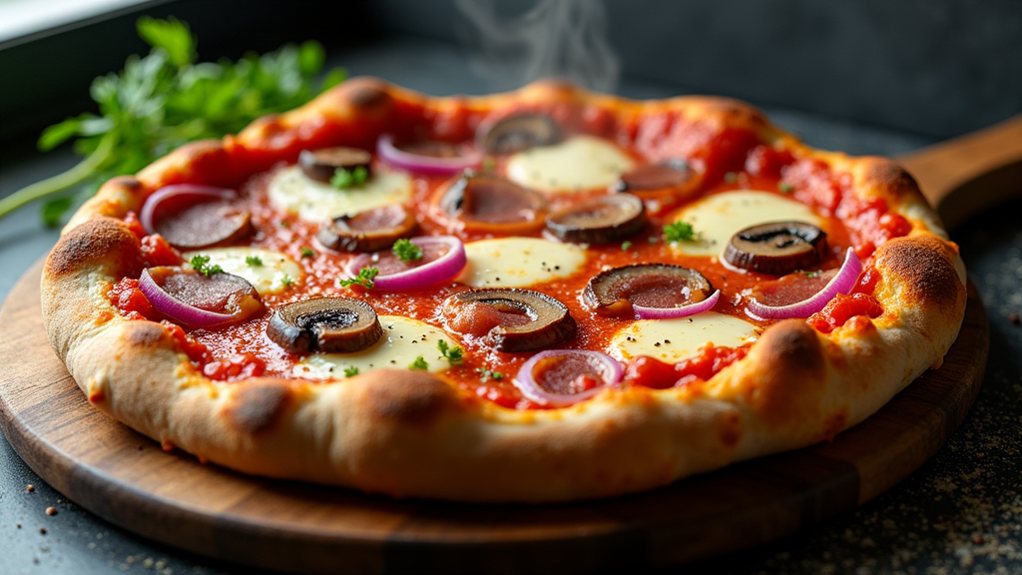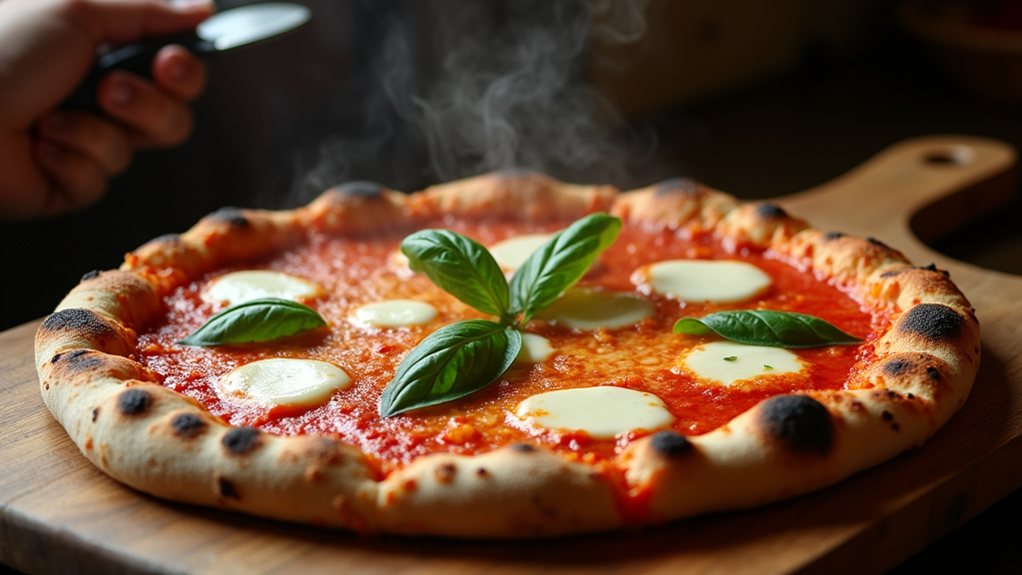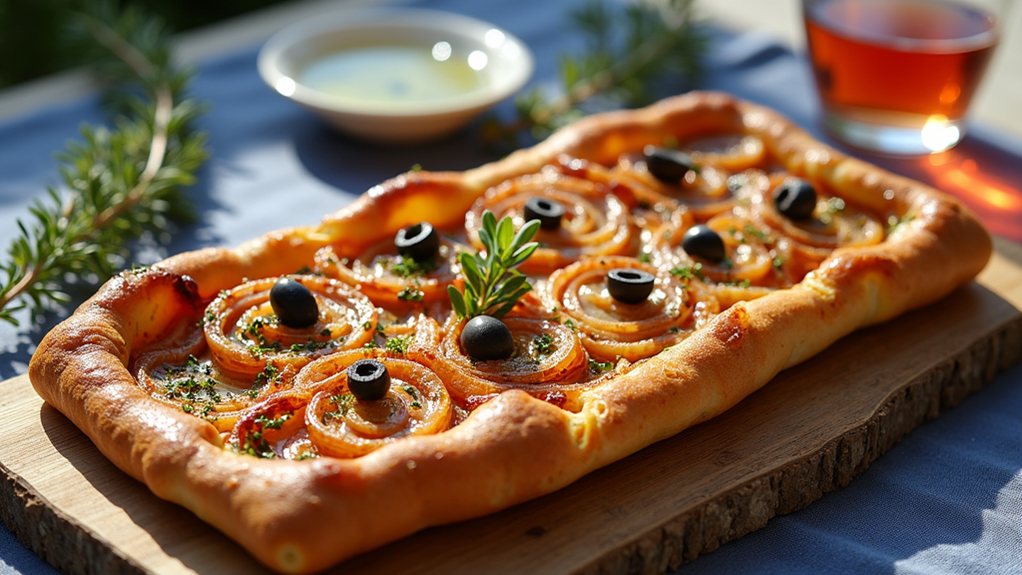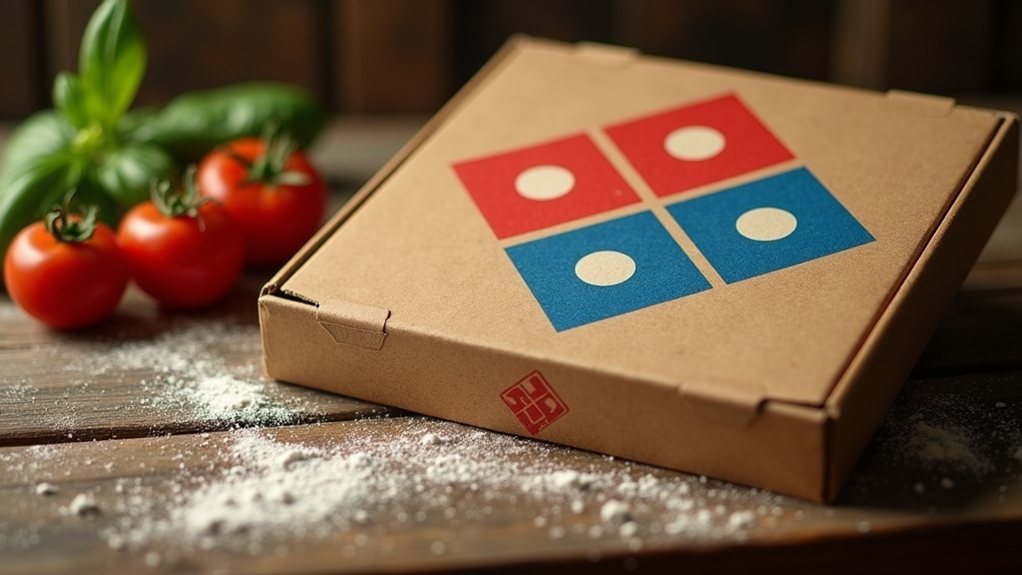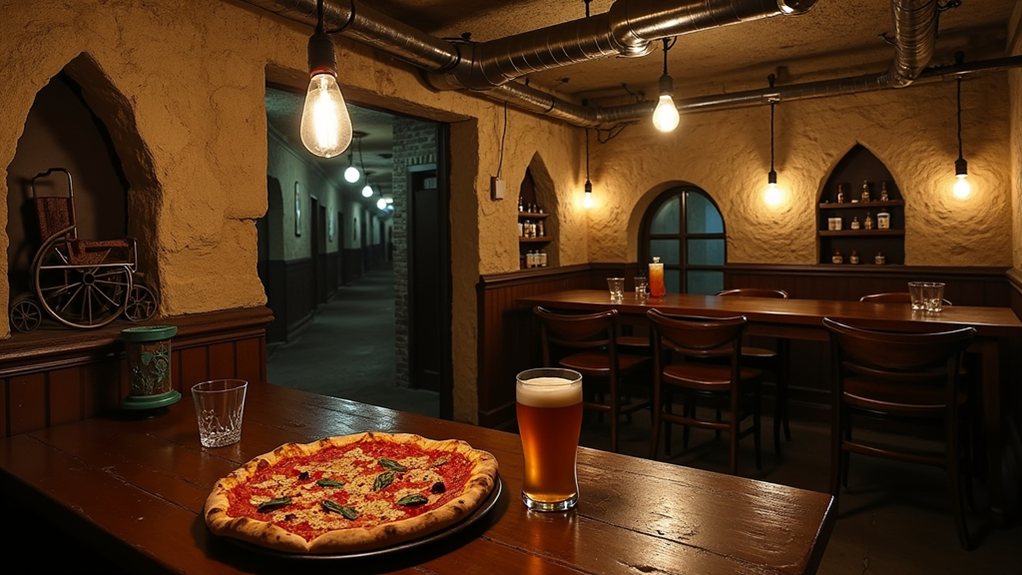Neapolitan pizza stands as Italy's most celebrated culinary ambassador, tracing its lineage to humble flatbreads of ancient Naples. This deceptively simple dish, perfected through generations of pizzaioli, transforms basic ingredients into transcendent flavor through meticulous technique. The pillowy-yet-crisp crust, bright tomatoes, and creamy mozzarella create a harmony that earned UNESCO cultural heritage status in 2017. Behind each authentic pie lies centuries of tradition, waiting to be uncovered bite by delicious bite.
The Ancient Roots of Neapolitan Pizza
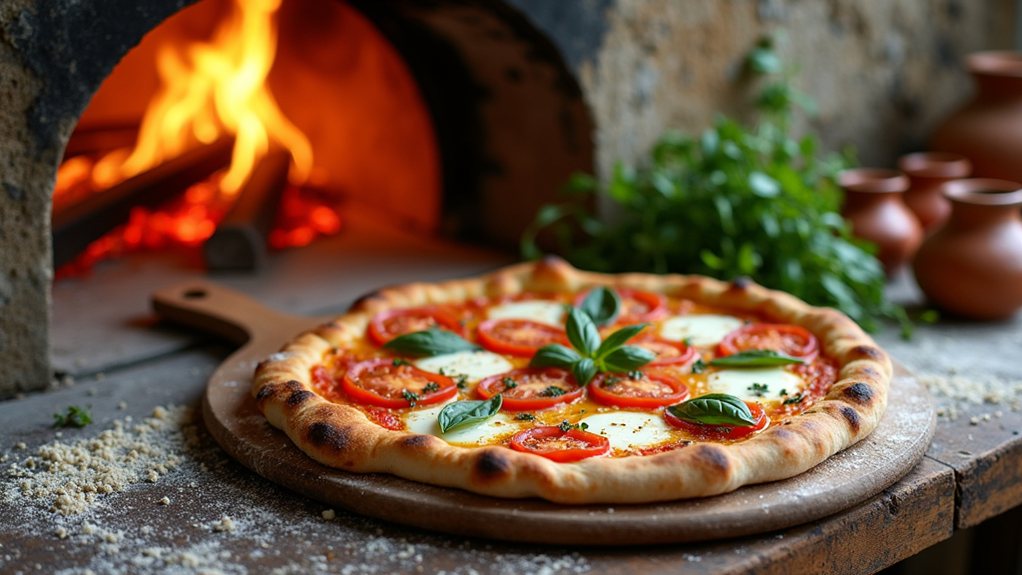
Nearly all culinary historians agree that the voyage of Neapolitan pizza began thousands of years before the dish we recognize today.
Ancient civilizations across the Mediterranean region, particularly the Egyptians, Greeks, and Romans, laid the foundation with their flatbreads, which were often topped with local herbs, oils, and occasionally cheese. The Greeks created plakous, round flatbreads garnished with onions and garlic, while Romans developed placenta, a honey-cheese combination that hinted at pizza's future evolution.
These early incarnations, though simple and unleavened, served as crucial staples for common people throughout the region. Unlike today's Neapolitan pizza with its characteristic leavened dough, these ancient flatbreads were practical, portable meals that crossed social boundaries. What we now celebrate as Neapolitan pizza was once considered cheap street food for the working class of Naples.
Naples' strategic position as a bustling port city would later facilitate the cultural exchange that transformed these humble beginnings into culinary history. The 18th century marked the true emergence of Neapolitan pizza with its slow fermentation techniques that eventually became central to its distinctive character.
From Royal Approval to UNESCO Recognition

While Neapolitan pizza had long been a cherished staple of Naples' working class, its course to international acclaim began with a pivotal royal visit in 1889. When Queen Margherita and King Umberto I visited Naples, pizzaiolo Raffaele Esposito created a patriotic pizza featuring the colors of the Italian flag. The queen's enjoyment of this creation, later named "Pizza Margherita," raised the dish's status beyond its humble origins. The distinctive plump, light dough absorbs the rich flavors of tomato and olive oil, setting it apart from other regional styles. Authentic Neapolitan pizza is characterized by its simple fresh toppings that highlight the quality of each ingredient rather than overwhelming the palate.
| Era | Milestone | Significance |
|---|---|---|
| 1889 | Royal Endorsement | Pizza gained upper-class acceptance |
| 1905 | Initial US Pizzeria | Global expansion began |
| 2017 | UNESCO Recognition | Official cultural heritage status |
This expedition culminated in 2017, when UNESCO recognized the art of Neapolitan pizzaiuolo as an Intangible Cultural Heritage of Humanity, cementing its global importance.
The Sacred Ingredients of Authentic Neapolitan Pizza
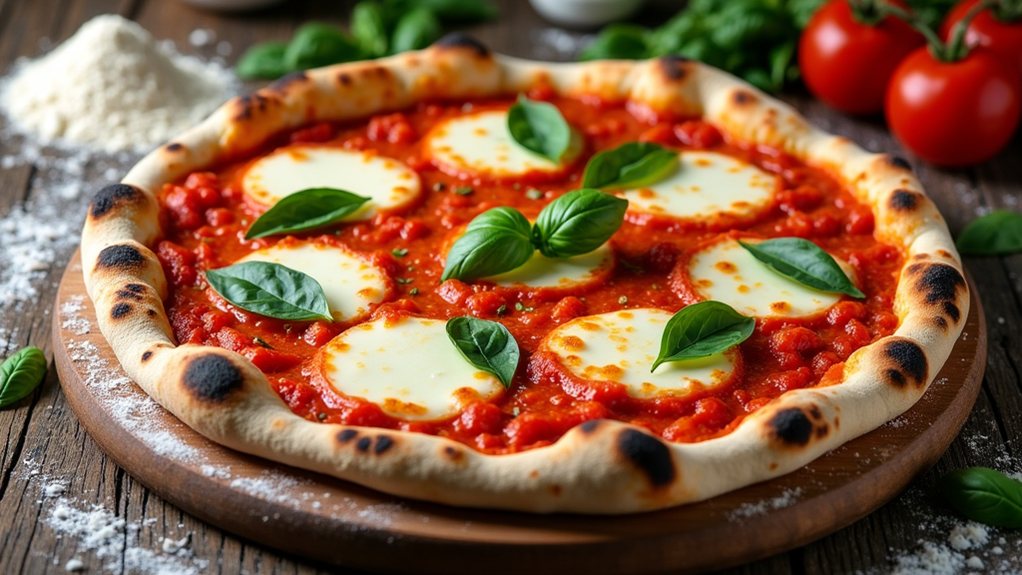
At the heart of any authentic Neapolitan pizza lies a sacred quartet of ingredients, each playing a vital role in creating the iconic dish that has enthralled food lovers worldwide.
The foundation begins with Italian Tipo 00 flour, prized for its fine texture and low gluten content, which creates that distinctively soft yet crispy crust. The simplicity of the dough's four essential ingredients—flour, water, yeast, and salt—highlights the importance of quality over quantity. For those attempting homemade Neapolitan pizza, allowing the dough to rise for 12-hours at room temperature develops its authentic flavor and texture.
San Marzano tomatoes, grown in the volcanic soil near Mount Vesuvius, provide the sweet, tangy sauce that balances the creamy richness of Mozzarella di Bufala.
Fresh basil completes the composition, adding aromatic depth to the pizza's flavor profile.
These ingredients, combined with proper technique—including the precise 55-62% dough hydration and 90-second cooking time in blazing 485°C ovens—ensure the authentic Neapolitan experience: a thin, slightly charred crust supporting minimal but high-quality toppings.
Mastering the Art of Neapolitan Dough
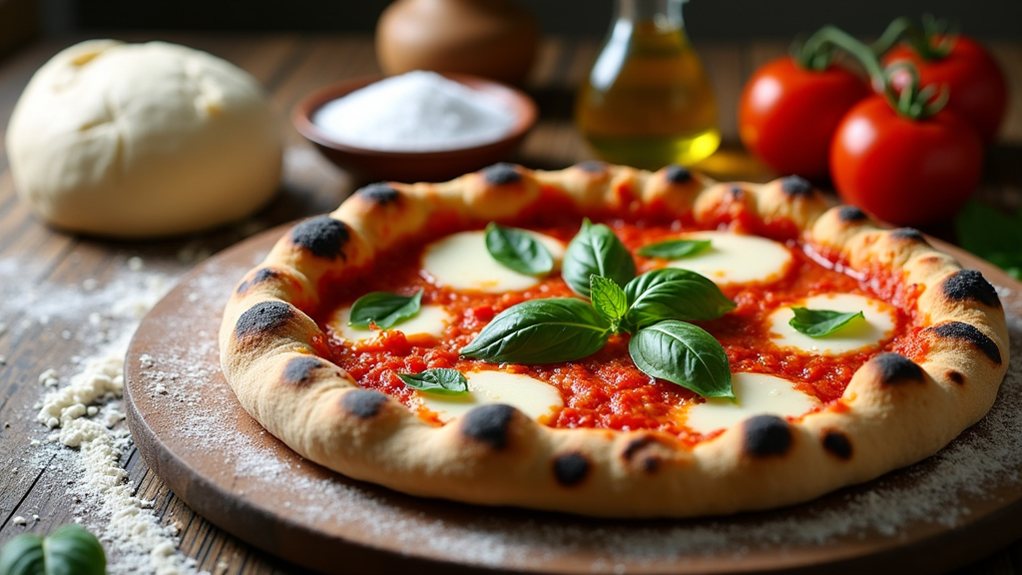
The true magic of Neapolitan pizza begins with its deceptively simple dough, a foundation that transforms just four humble ingredients into culinary perfection. The process demands patience, technique, and respect for tradition, allowing bakers to craft a crust that's simultaneously chewy and crisp.
| Stage | Time | Key Technique |
|---|---|---|
| Initial Mix | 5 minutes | Combine 00 flour, water, yeast |
| Fermentation | 24-72 hours | Cold rise in refrigerator |
| Final Shaping | 2-3 minutes | Hand-stretch without rolling |
The dough's progression includes extensive kneading to develop elasticity, followed by a long fermentation that builds complex flavors. Before baking, the dough rests at room temperature, then experienced pizzaiolos gently stretch it by hand, preserving the air pockets that will create the signature leopard-spotted char.
Wood-Fired Magic: The Traditional Baking Method
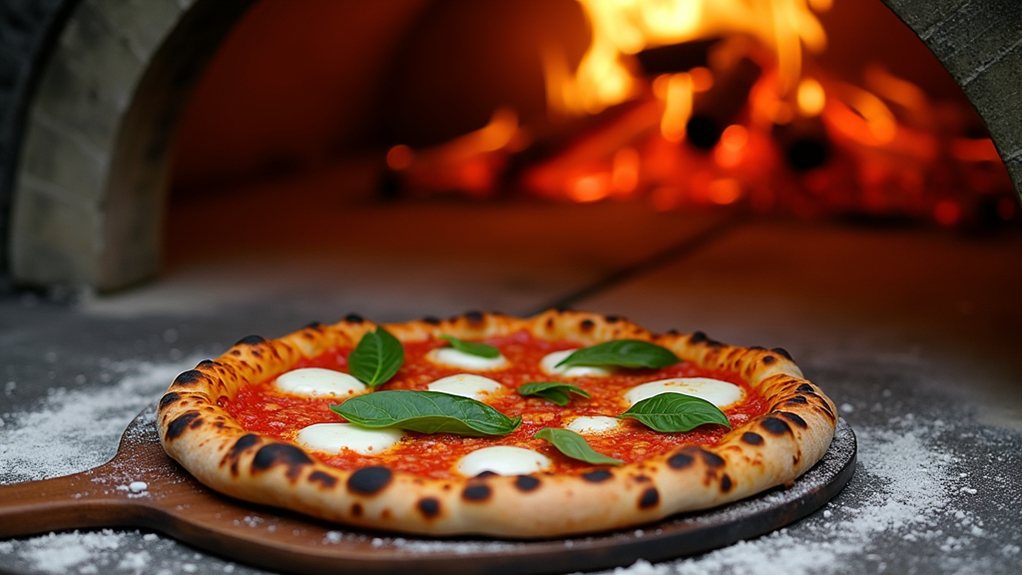
Situated within the heart of Neapolitan pizza tradition lies the wood-fired oven, an essential element that transforms simple dough into culinary artistry through intense heat and aromatic smoke.
These dome-shaped structures, crafted from refractory materials, reach temperatures of 800°F, allowing pizzas to cook in just 60-90 moments.
Hardwoods like oak and beech fuel these ovens, imparting a distinctive smokiness that improves the pizza's flavor profile and complements the sweetness of tomatoes and richness of mozzarella.
The even heat distribution guarantees a consistent cook, creating the hallmark charred, crispy exterior with a chewy interior that defines authentic Neapolitan pizza.
While home alternatives exist, such as pizza stones and specialized techniques, the traditional wood-fired method remains unmatched in delivering the authentic experience that has made this style world-renowned.
Classic Varieties: Beyond the Margherita
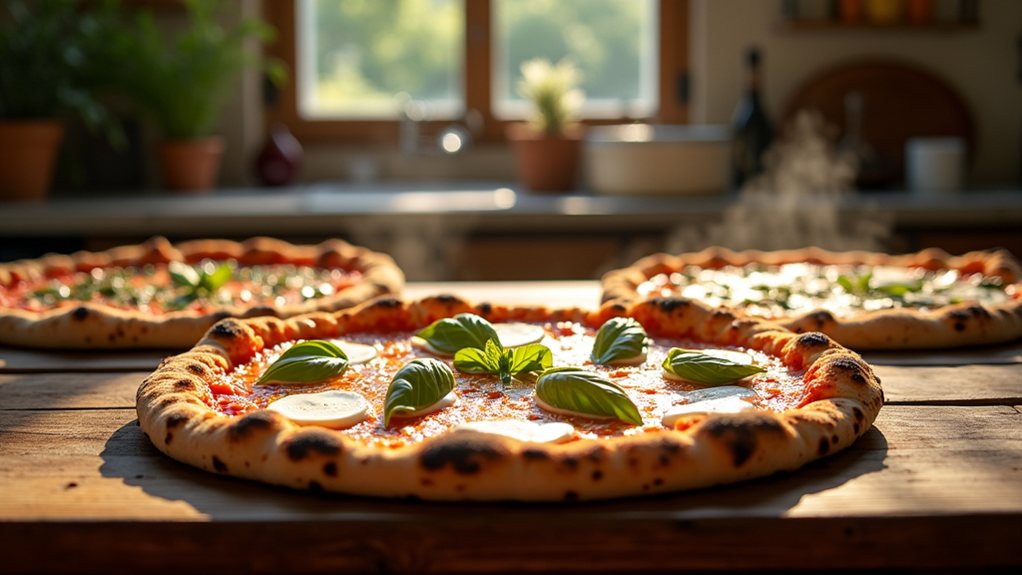
While Pizza Margherita reigns as Italy's most famous creation, authentic Neapolitan cuisine offers a diverse array of comparably remarkable varieties, each telling its own story through carefully selected ingredients and time-honored traditions.
Beyond the Margherita lies a world of Neapolitan pizza treasures waiting to be savored and celebrated.
The marinara, perhaps older than the Margherita itself, showcases a brilliant simplicity with tomato sauce, garlic, oregano, and olive oil, clearly omitting cheese entirely.
Pizza Bianca, or "white pizza," takes a different approach, foregoing tomato sauce in favor of garlic, olive oil, and fragrant rosemary.
Beyond these classics, regional variants incorporate anchovies, capers, or multiple cheeses in the Quattro Formaggi.
Each variation adheres to the same exacting standards—hand-stretched dough made from type 00 flour, carefully balanced flavors, and quick cooking that preserves the delicate texture that distinguishes true Neapolitan pizza.
Neapolitan Pizza in the Modern World
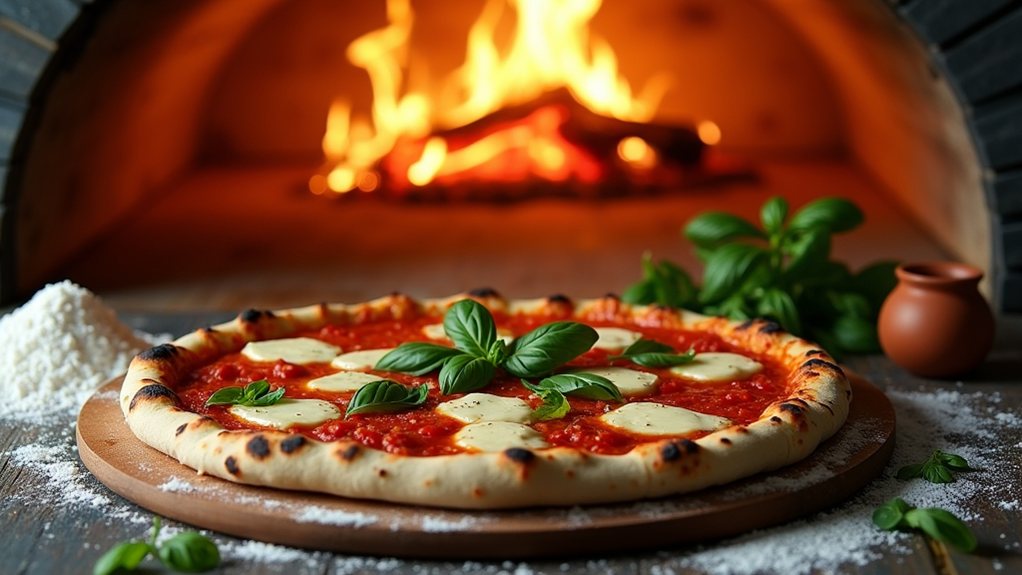
From its humble beginnings in the alleyways of Naples to global culinary stardom, Neapolitan pizza has undergone a remarkable expedition through time and across continents. This UNESCO-recognized tradition now balances authenticity with innovation, as modern pizzaiolos experiment with techniques like extended fermentation and alternative grains while respecting traditional methods.
| Evolution | Traditional | Modern | Neo-Neapolitan |
|---|---|---|---|
| Dough | Simple, basic | High hydration | Heavier dough balls |
| Fermentation | Short | 24+ hours | Extended cold proof |
| Oven | Wood-fired only | Wood or electric | Diverse high-temp |
| Texture | Soft, foldable | Similar but airier | Crunchier crust |
| Approach | Strict rules | Flexible tradition | Creative innovation |
The rise of home pizza ovens has democratized this once-exclusive craft, allowing enthusiasts worldwide to recreate authentic Neapolitan experiences in their kitchens, furthering pizza's cultural influence.
FAQs
Can Neapolitan Pizza Be Made in a Home Oven?
Neapolitan pizza can be made in home ovens with adaptations. Bakers achieve reasonable results using pizza stones, high heat settings, and modified techniques to compensate for temperature limitations typical of standard residential ovens.
What Wine Pairs Best With Authentic Neapolitan Pizza?
For authentic Neapolitan pizza, bright, acidic wines balance the tomato sauce perfectly. Falanghina offers regional authenticity, while light reds like Barbera or sparkling options such as Col Fondo Prosecco provide delightful alternatives.
How Did Neapolitan Pizza Influence American Pizza Styles?
Neapolitan pizza influenced American styles when Italian immigrants adapted their traditional techniques to local ingredients and preferences, spawning regional variations like New York's foldable slices and New Haven's coal-fired approach.
Is Gluten-Free Neapolitan Pizza Considered Authentic?
Gluten-free Neapolitan pizza isn't considered authentic by traditional standards. The AVPN certification requires Type 0 or 00 flour containing gluten, making gluten-free versions technically non-traditional despite similar ingredients and methods.
How Do Seasonal Changes Affect Traditional Neapolitan Pizza Ingredients?
Seasonal changes considerably impact Neapolitan pizza's core ingredients. Summer offers peak-quality basil and fresh tomatoes, while winter relies on preserved San Marzano tomatoes. Traditional pizzerias adjust their offerings accordingly to maintain authenticity.


